Mary Rose museum opens in Portsmouth at cost of £35m
- Published

A volley of flaming arrows was fired from Southsea Castle during the museum's opening-day events
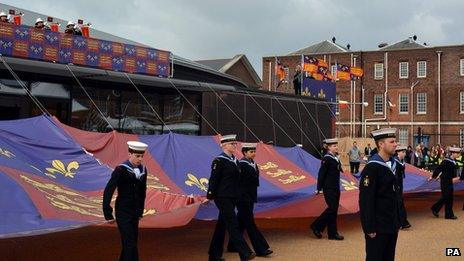
Royal Navy Sea Cadets lowered the Tudor standard to mark the museum's official opening
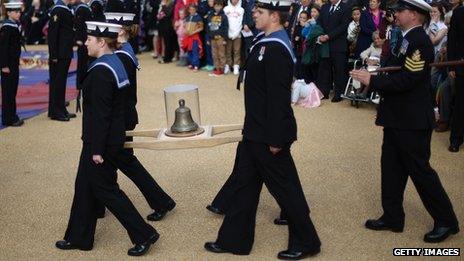
Crew members from HMS Duncan carry the original ship's bell to the The Mary Rose Museum during the opening ceremony

Crew from HMS Duncan laid a wreath at the wreck site of the Mary Rose
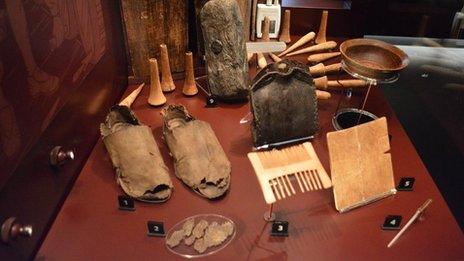
Thousands of personal items were found such as these, belonging to the purser
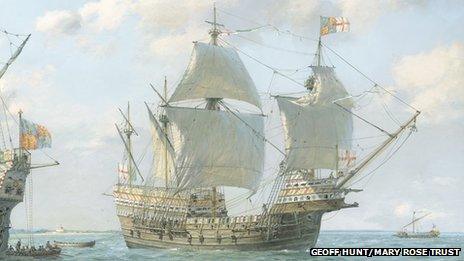
This painting by Geoff Hunt shows what the Mary Rose would have looked like
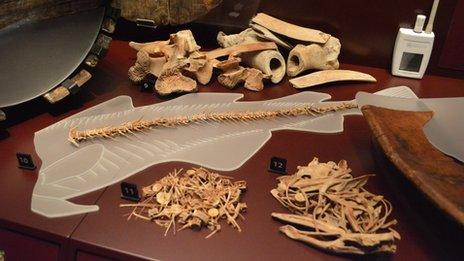
The backbone of a cod that went uneaten was among the food items found on board
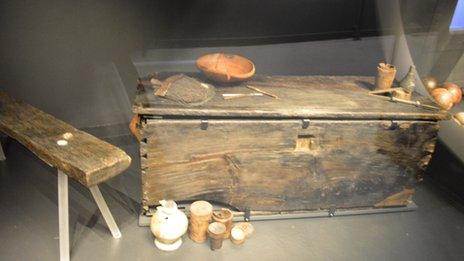
A recreation of the surgeon's quarters on board - the bench was used for amputating limbs
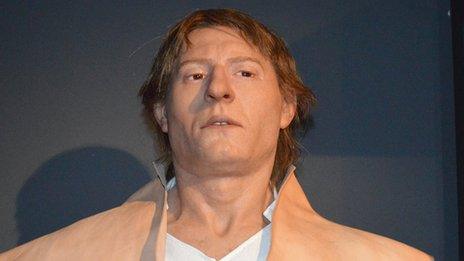
This is the recreated face of an archer - one of 92 near complete skeletons
A £35m purpose-built museum for Henry VIII's flagship, the Mary Rose, has been officially opened in Portsmouth.
The 16th Century hull will once again be on display at the Historic Dockyard museum - yards from where the Tudor warship was built 500 years ago.
The new museum finally reunites the Mary Rose with many thousands of the 19,000 artefacts found with it.
The ship was discovered in 1971 and raised from the seabed of the Solent in 1982.
The new museum will be fully open to the public from Friday but tickets have to be booked in advance.
Faces of some of the crew have been recreated by forensic science experts using skulls found with the wreck.
The areas of the ship where they lived and worked, such as the surgeon's cabin and the gun deck have also been recreated.
Wreath laying
Up to 500 men and boys died when the ship sank and the new museum has been dedicated to them.
A day of events to mark the opening started with the laying of a wreath at the spot where it sank.
The Reverend Monsignor Andrew McFadden said: "Today is as much about the men as it is about the ship. Similar prayers would have been said on the Mary Rose.
"The skeletons represent the spirit of those people who gave their lives on the Mary Rose, and the bell represents a continuation of them and the ship today."
The Mary Rose Bell was then taken from the wreck site to HMS Duncan.
A giant Tudor flag covered the museum before it was lowered to a fanfare by the band of the Royal Marines earlier.
The day-long event has marked the symbolic journey of the ship's bell as the last artefact to be placed into the new Mary Rose museum ahead of its public opening.
Since it was brought up, the hull had been constantly sprayed with water and wax chemicals but the jets were turned off last month.
For the next four years it will be kept in a "hot box" chamber to be dried out but visitors to Portsmouth Historic Dockyard will be able to view it through windows.
'Beyond belief'
After that the hull will be on full view in the museum, in which a mirror image of the decks has been created to give people a feeling of what life was like on the ship.
John Lippiett, chief executive of the Mary Rose Trust, said: "People don't believe these things come from the ship.
"We even had the bishop of Portsmouth in here the other day, saying it was 'beyond belief'.
"But everything you see behind glass here was found with it.
"[While the drying out takes place] over the next four years you will be seeing people working on it, which puts the size of the ship into perspective."
The Mary Rose saw 34 years of service before it sank while leading an attack on a French invasion fleet in 1545.
King Henry VIII watched from Southsea Castle as it disappeared, killing all but 35 of the crew. Most of them drowned, trapped underneath netting designed to prevent the enemy from boarding.
The bulk of the £35m funding for the museum and conservation project came from a £23m Heritage Lottery Fund grant, with remaining cash raised through various charitable trusts, fundraising and sponsors.
- Published30 May 2013
- Published30 May 2013
- Published30 May 2013
- Published29 May 2013
- Published30 April 2013
- Published2 April 2013
- Published13 February 2013